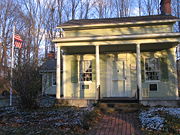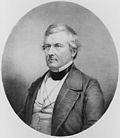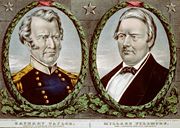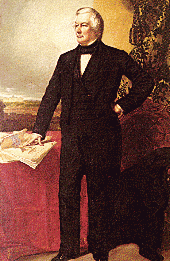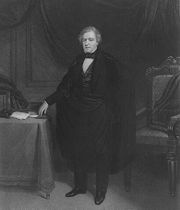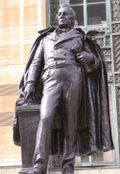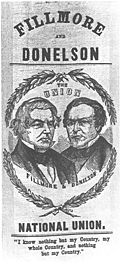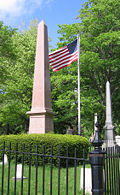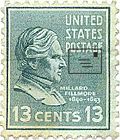Millard Fillmore
2008/9 Schools Wikipedia Selection. Related subjects: USA Presidents
|
Millard Fillmore
|
|
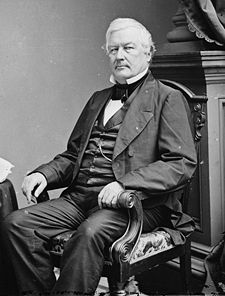 President Millard Fillmore, taken around 1850 by Matthew Brady |
|
|
|
|
|---|---|
| In office July 9, 1850 – March 4, 1853 |
|
| Vice President | none |
| Preceded by | Zachary Taylor |
| Succeeded by | Franklin Pierce |
|
12th Vice President of the United States
|
|
| In office March 4, 1849 – July 9, 1850 |
|
| President | Zachary Taylor |
| Preceded by | George M. Dallas |
| Succeeded by | William R. King |
| Incumbent | |
| Assumed office November 4, 1856 |
|
|
|
|
| Born | January 7, 1800 Summerhill, New York |
| Died | March 8, 1874 (aged 74) Buffalo, New York |
| Nationality | American |
| Political party | Anti-Masonic, Whig, American |
| Spouse | Abigail Powers Fillmore (1st wife) Caroline Carmichael McIntosh Fillmore (2nd wife) |
| Alma mater | New Hope Academy |
| Occupation | Lawyer |
| Religion | Unitarian |
| Signature | |
Millard Fillmore (pronounced /ˈmɪlɚd ˈfɪlmɔər/; January 7, 1800 – March 8, 1874) was the thirteenth President of the United States, serving from 1850 until 1853, and the last member of the Whig Party to hold that office. He was the second Vice President to assume the Presidency upon the death of a sitting President, succeeding Zachary Taylor who died of what is thought to be acute gastroenteritis or hyperthermia (heat stroke). Fillmore was never elected President; after serving out Taylor's term, he failed to gain the nomination for the Presidency of the Whigs in the 1852 presidential election, and, four years later, in the 1856 presidential election, he again failed to win election as the Know Nothing Party and Whig candidate.
Early life and career
Fillmore was born in a log cabin in Cayuga County, New York, to Nathaniel Fillmore and Phoebe Millard, as the second of nine children and the eldest son. (As this was three weeks after George Washington's death, Fillmore was the first U.S. President born after the death of a former president.) Though a Unitarian in later life, Fillmore was descended from Scottish Presbyterians on his father's side and English dissenters on his mother's. His father apprenticed him to a brutal cloth maker in Sparta, New York, at age fourteen to learn the cloth-making trade. He left after four months but subsequently took another apprenticeship in the same trade at New Hope, New York. He struggled to obtain an education under frontier conditions, attending New Hope Academy for six months in 1819. Later that same year, he began to clerk for Judge Walter Wood of Montville, New York, under whom Fillmore began to study law.
He fell in love with Abigail Powers, whom he met while at New Hope Academy and later married on February 26, 1826. The couple had two children, Millard Powers Fillmore and Mary Abigail Fillmore. After leaving Wood and buying out his apprenticeship, Fillmore moved to Buffalo, New York, where he continue his studies in the law office of Asa Rice and Joseph Clary. He was admitted to the bar in 1823 and began his law practice in East Aurora. In 1834, he formed a law partnership, Fillmore and Hall (becoming Fillmore, Hall and Haven in 1836), with his good friend Nathan K. Hall (who would later serve in his cabinet as Postmaster General). It would become one of western New York's most prestigious firms.
In 1846, he founded the private University of Buffalo, which today is the public State University of New York at Buffalo (UB, University at Buffalo), the largest school in the New York state university system.
His military service was limited. He served in the New York militia during the Mexican War of 1846 and during the American Civil War.
Politics
In 1828, Fillmore was elected to the New York State Assembly on the Anti-Masonic ticket, serving for one term, from 1829 to 1831. He was later elected as a Whig (having followed his mentor Thurlow Weed into the party) to the 23rd Congress in 1832, serving from 1833 to 1835. He was re-elected in 1836 to the 25th Congress, to the 26th and to the 27th Congresses serving from 1837 to 1843, declining to be a candidate for re-nomination in 1842.
In Congress, he opposed the entrance of Texas as a slave territory. He came in second place in the bid for Speaker of the House of Representatives in 1841. He served as chairman of the House Ways and Means Committee from 1841 to 1843 and was an author of the Tariff of 1842, as well as two other bills that President John Tyler vetoed.
After leaving Congress, Fillmore was the unsuccessful Whig candidate for Governor of New York in 1844. He was the first New York State Comptroller elected by general ballot, and was in office from 1848 to 1849. As state comptroller, he revised New York's banking system, making it a model for the future National Banking System.
Vice Presidency 1849–1850
At the Whig national convention in 1848, the nomination of Gen. Zachary Taylor for president angered the supporters of Henry Clay as well as the opponents of slavery extension into the territory gained by the U.S.-Mexican War. A group of practical Whig politicians nominated Fillmore for vice president, believing that he would heal party wounds and help the ticket carry New York state.
Having worked his way up through the Whig Party in New York, Fillmore was selected as Taylor's running mate. It was thought that the obscure, self-made candidate from New York would complement Taylor, a slave-holding military man from the south.
Fillmore was also selected in part to block New York state machine boss Thurlow Weed from receiving the vice presidential nomination (and his front man William H. Seward from receiving a position in Taylor's cabinet). Weed ultimately got Seward elected to the senate. This competition between Seward and Fillmore led to Seward's becoming a more vocal part of cabinet meetings and having more of a voice than Fillmore in advising the administration. The battle would continue even after Taylor's death.
Taylor and Fillmore disagreed on the slavery issue in the new western territories taken from Mexico in the Mexican-American War. Taylor wanted the new states to be free states, while Fillmore supported slavery in those states as a means of appeasing the South. In his own words: "God knows that I detest slavery, but it is an existing evil... and we must endure it and give it such protection as is guaranteed by the Constitution."
Fillmore presided over the Senate during the months of nerve-wracking debates over the Compromise of 1850. During one debate, Senator Henry S. Foote of Mississippi pulled a pistol on Senator Thomas Hart Benton of Missouri. Fillmore made no public comment on the merits of the compromise proposals, but a few days before President Taylor's death, Fillmore suggested to the president that, should there be a tie vote on Henry Clay's bill, he would vote in favour of the North.
Presidency 1850–1853
Policies
Fillmore ascended to the presidency upon the sudden and unexpected death of President Taylor in July 1850. The change in leadership also signaled an abrupt political shift as Fillmore appointed his own cabinet. Taylor, himself, had been about to replace his entire scandal-ridden cabinet at the time of his death, but now, beginning with the appointment of Daniel Webster as Secretary of State, Fillmore's cabinet would be dominated by individuals who, with the exception of Treasury Secretary Thomas Corwin, favored what would come to be called the Compromise of 1850.
As president, Fillmore dealt with increasing party divisions within the Whig party; party harmony became one of his primary objectives. He tried to unite the party by pointing out the differences between the Whigs and the Democrats (by proposing tariff reforms that negatively reflected on the Democratic Party). Another primary objective of Fillmore was to preserve the Union from the intensifying slavery debate.
Henry Clay's proposed bill to admit California to the Union still aroused all the violent arguments for and against the extension of slavery without any progress toward settling the major issues (the South continued to threaten secession). Fillmore recognized that Clay's plan was the best way to end the sectional crisis (California free state, harsher fugitive slave law, abolish slave trade in DC). Clay, exhausted, left Washington to recuperate, passing leadership to Senator Stephen A. Douglas of Illinois. At this critical juncture, President Fillmore announced his support of the Compromise of 1850.
On August 6, 1850, he sent a message to Congress recommending that Texas be paid to abandon its claims to part of New Mexico. This, combined with his mobilization of 750 Federal troops to New Mexico, helped shift a critical number of northern Whigs in Congress away from their insistence upon the Wilmot Proviso—the stipulation that all land gained by the Mexican War must be closed to slavery.
Douglas's effective strategy in Congress combined with Fillmore's pressure gave impetus to the Compromise movement. Breaking up Clay's single legislative package, Douglas presented five separate bills to the Senate:
- Admit California as a free state.
- Settle the Texas boundary and compensate the state for lost lands.
- Grant territorial status to New Mexico.
- Place federal officers at the disposal of slaveholders seeking escapees—the Fugitive Slave Act.
- Abolish the slave trade in the District of Columbia.
Each measure obtained a majority, and, by September 20, President Fillmore had signed them into law. Webster wrote, "I can now sleep of nights." Whigs on both sides refused to accept the finality of Fillmore's law (which led to more party division, and a loss of numerous elections), which forced Northern Whigs to say "God Save us from Whig Vice Presidents."
Fillmore's greatest difficulty with the fugitive slave law was how to enforce it without seeming to show favour towards Southern Whigs. His solution was to appease both northern and southern Whigs by calling for the enforcement of the fugitive slave law in the North, and enforcing in the South a law forbidding involvement in Cuba (for the sole purpose of adding it as a slave state).
Another issue that presented itself during Fillmore's presidency was the arrival of Louis Kossuth (exiled leader of a failed Hungarian revolution). Kossuth wanted the United States to abandon its non-intervention policies when it came to European affairs and recognize Hungary’s independence. The problem came with the enormous support Kossuth received from German-American immigrants to the United States (who were essential in the re-election of both Whigs and Democrats). Fillmore refused to change American policy, and decided to remain neutral despite the political implications that neutrality would produce.
Fillmore appointed Brigham Young as the first governor of the Utah Territory in 1850. Utah now contains a city and county named after Millard Fillmore.
Another important legacy of Fillmore's administration was the sending of Commodore Matthew C. Perry to open Japan to Western trade, though Perry did not reach Japan until Franklin Pierce had replaced Fillmore as president. A less dramatic legacy is that Fillmore, a bookworm, found the White House devoid of books and initiated the White House library.
Administration and cabinet
| The Fillmore Cabinet | ||
|---|---|---|
| Office | Name | Term |
| President | Millard Fillmore | 1850–1853 |
| Vice President | None | 1850–1853 |
| Secretary of State | Daniel Webster | 1850–1852 |
| Edward Everett | 1852–1853 | |
| Secretary of Treasury | Thomas Corwin | 1850–1853 |
| Secretary of War | Charles M. Conrad | 1850–1853 |
| Attorney General | John J. Crittenden | 1850–1853 |
| Postmaster General | Nathan K. Hall | 1850–1852 |
| Samuel D. Hubbard | 1852–1853 | |
| Secretary of the Navy | William A. Graham | 1850–1852 |
| John P. Kennedy | 1852–1853 | |
| Secretary of the Interior | Thomas M. T. McKennan | 1850 |
| Alexander H. H. Stuart | 1850–1853 | |
Supreme Court appointments
Fillmore appointed the following Justices to the Supreme Court of the United States:
- Benjamin Robbins Curtis - 1851 (Associate Justice)
States admitted to the Union
- California – September 9, 1850
Legacy
Some northern Whigs remained irreconcilable, refusing to forgive Fillmore for having signed the Fugitive Slave Act. They helped deprive him of the Presidential nomination in 1852. Within a few years it was apparent that although the Compromise had been intended to settle the slavery controversy, it served rather as an uneasy sectional truce. Robert J. Rayback argues that the appearance of a truce, at first, seemed very real as the country entered a period of prosperity that included the South. Although Fillmore, in retirement, continued to feel that conciliation with the South was necessary and considered that the Republican Party was at least partly responsible for the subsequent disunion, he was an outspoken critic of secession and was also critical of President Buchanan for not immediately taking military action when South Carolina seceded.
Benson Lee Grayson suggests that the skillful avoidance of potential problems by the Fillmore administration is too often overlooked. Fillmore's constant attention to Mexico avoided a resumption of the hostilities that had only broken off in 1848 and laid the groundwork for the Gadsen Treaty during Pierce's administration. Meanwhile, the Fillmore administration ironed out a serious dispute with Portugal left over from the Taylor administration, smoothed over a disagreement with Peru, and then peacefully resolved other disputes with England, France, and Spain over Cuba. At the height of this crisis, the Royal Navy had fired on an American ship while at the same time 160 Americans were being held captive in Spain. Fillmore and his State Department were able to resolve these crises without the United States going to war or losing face.
Because the Whig party was so deeply divided, and the two leading national figures in the Whig party (Fillmore and his own Secretary of State, Daniel Webster) refused to combine to secure the nomination, Winfield Scott received it. Because both the north and the south refused to unite behind Scott, he won only 4 of 31 states, and lost the election to Franklin Pierce.
After Fillmore's defeat the Whig party continued its downward spiral with further party division coming at the hands of the Kansas Nebraska Act, and the emergence of the Know Nothing party.
Later life
Fillmore was one of the founders of the University of Buffalo. The school was chartered by an act of the New York State Legislature on May 11, 1846, and at first was only a medical school. Fillmore was the first Chancellor, a position he maintained while both Vice President and President. Upon completing his presidency, Fillmore returned to Buffalo, where he continued to serve as chancellor.
After the death of his daughter Mary, Fillmore went abroad. While touring Europe in 1855, Fillmore was offered an honorary Doctor of Civil Law (D.C.L.) degree by the University of Oxford. Fillmore turned down the honour, explaining that he had neither the "literary nor scientific attainment" to justify the degree. He is also quoted as having explained that he "lacked the benefit of a classical education" and could not, therefore, understand the Latin text of the diploma, adding that he believed "no man should accept a degree he cannot read."
By 1856, Fillmore's Whig Party had ceased to exist, having fallen apart due to dissension over the slavery issue, and especially the Kansas-Nebraska Act of 1854. Fillmore refused to join the new Republican Party, where many former Whigs, including Abraham Lincoln, had found refuge. Instead, Fillmore joined the anti-immigrant, anti-Catholic American Party, the political organ of the Know-Nothing movement. He ran in the election of 1856 as the party's presidential candidate, attempting to win a non-consecutive second term as President (a feat accomplished only once in American politics, by Grover Cleveland). His running mate was Andrew Jackson Donelson, nephew of former president Andrew Jackson. Fillmore and Donelson finished third, carrying only the state of Maryland and its eight electoral votes; but he won 21.6% of the popular vote, one of the best showings ever by a Presidential third-party candidate.
On February 10, 1858, after the death of his first wife, Fillmore married Caroline McIntosh, a wealthy widow. Their combined wealth allowed them to purchase a big house in Buffalo, New York. The house became the centre of hospitality for visitors, until her health began to decline in the 1860s.
Throughout the Civil War, Fillmore opposed President Lincoln and during Reconstruction supported President Johnson. He commanded the Union Continentals, a corps of home guards of males over the age of 45 from the Upstate New York area, during the Civil War.
He died at 11:10 p.m. on March 8, 1874, of the after-effects of a stroke. His last words were alleged to be, upon being fed some soup, "the nourishment is palatable." On January 7 each year, a ceremony is held at his grave site in the Forest Lawn Cemetery in Buffalo.
Places named after Fillmore
- Fillmore Glen State Park, New York
- Fillmore County, Minnesota
- Fillmore County, Nebraska
- Fillmore, Utah
- Millard County, Utah
- Fillmore Avenue, on the East Side of Buffalo, New York
- Millard Fillmore Gates Circle Hospital, Buffalo
- Millard Fillmore Suburban Hospital, Williamsville, New York
- Millard Fillmore Academic Centre at the University at Buffalo's Ellicott Complex
- Fillmore Street, in downtown San Francisco, California, after which, in turn, the Fillmore Auditorium was named
- Fillmore Street, in downtown Phoenix, Arizona
- Fillmore Elementary School, Hamilton, Ohio
Trivia
- Fillmore Junior High School in the television series The Brady Bunch
- The 1980s sitcom Head of the Class took place at the fictional "Millard Fillmore High School".
- The comic strip Mallard Fillmore is named after the president.
- In 2007, George Pendle wrote The Remarkable Millard Fillmore, a fake biography based on real events that happened in Fillmore's life.
- In February 2008, a television commercial for a sales event by Kia Motors featured Millard Fillmore, referring to him as "Unheard of," claims he had the first bathtub installed in the White House, and presented a Millard Fillmore bust as a 'Soap-On-A-Rope.' This story may have begun as a hoax by Henry Louis Mencken.
- The myth that Millard Fillmore installed the White House's first bathtub was started by H. L. Mencken in a joke column published on December 28, 1917 in the New York Evening Mail. (See Bathtub hoax)
- Millard Fillmore was the last U.S. president who was neither a Democrat nor a Republican (although Abraham Lincoln was re-elected in 1864 running on the National Union Party ticket with Democrat Andrew Johnson as his running mate).
- Fillmore is the first of two presidents to have been an indentured servant. He was a clothmaker.
- Friends of Millard Filmore, or FOMF, is an annual trivia hunt founded by Dr. Robert Hunter in 1967 at Carlmont High School, several schools in Northern California participate in this highly competitive event.
Electoral history
United States presidential election, 1848
- Zachary Taylor/Millard Fillmore (Whig) - 1,361,393 (47.3%) and 163 electoral votes (16 states carried)
- Lewis Cass/ William Orlando Butler (Democrats) - 1,223,460 (42.5%) and 127 electoral votes (15 states carried)
- Martin Van Buren/ Charles Francis Adams, Sr. (Free Soil) - 291,501 (10.1%) and 0 electoral votes
United States presidential election, 1856
- James Buchanan/ John C. Breckinridge (Democrats) - 1,836,072 (45.3%) and 174 electoral votes (19 states carried)
- John C. Fremont/ William L. Dayton (Republicans) - 1,342,345 (33.1%) and 114 electoral votes (11 states carried)
- Millard Fillmore/ Andrew Jackson Donelson (Know-Nothing/Whig) - 873,053 (21.6%) and 8 electoral votes (1 state carried)
